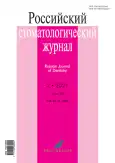Associated parallels of the initial potential mineralization value of oral fluid and intensity of dental caries in children with cleft lip and palate
- Authors: Ashurov G.G.1, Ismoilov A.A.1
-
Affiliations:
- Institute of Postgraduate Education in Health Sphere of the Republic of Tajikistan
- Issue: Vol 25, No 2 (2021)
- Pages: 101-106
- Section: Experimental and Theoretical Investigation
- URL: https://journals.rcsi.science/1728-2802/article/view/105033
- DOI: https://doi.org/10.17816/1728-2802-2021-25-2-101-106
- ID: 105033
Cite item
Abstract
BACKGROUND: Cleft upper lip and palate is the most common malformation of the maxillofacial region. Despite the huge successes that have been achieved by dental surgeons in eliminating such defects, the issues of studying the initial indicators of the cariesological status in children with congenital cleft lip and palate are still not fully resolved. The study of the above issues will allow us to correct the plan of therapeutic and preventive action, which will lead to effective rehabilitation of children with cleft lip and palate.
AIM: This study aimed to conduct a clinical assessment of the initial mineralizing ability of oral fluids in children with congenital cleft lip and palate depending on the cariology status.
MATERIAL AND METHODS: This study presented the results of the clinical assessment of the initial value of the mineralizing ability of oral fluid depending on the intensity of dental caries in children with congenital cleft lip and palate. To determine the mineralizing ability of mixed saliva, 76 teeth of pediatric volunteers with congenital cleft lip and palate with a high level of mineralization potential of oral fluid, with medium, low, and very low levels of the studied indicator, were examined. The level of the mineralizing ability of mixed saliva was determined by visualization depending on the involvement of functionally oriented groups of teeth with caries.
RESULTS: The general characteristics of the mineralization potential of oral fluids, depending on the intensity of dental caries, help determine that with mild caries, the average value of the studied indicator was 21.9%, at an average intensity level of 31.0%, at a high intensity level of 47.1%.
CONCLUSIONS: An inverse-diameter dependence was found in the intensity level of caries on the mineralizing ability of oral fluids.
Full Text
##article.viewOnOriginalSite##About the authors
Gayur G. Ashurov
Institute of Postgraduate Education in Health Sphere of the Republic of Tajikistan
Author for correspondence.
Email: shakh92@mail.ru
MD, Dr. Sci. (Med.), Professor
Tajikistan, 59, avenue Ismoili Somoni, Dushanbe, 734026Abdurakhim A. Ismoilov
Institute of Postgraduate Education in Health Sphere of the Republic of Tajikistan
Email: shakh92@mail.ru
MD, Dr. Sci. (Med.), Professor
Tajikistan, 59, avenue Ismoili Somoni, Dushanbe, 734026References
- Korolenkova MV, Starikova NV, Ageeva LV. Risk factors for dental aplasia and hypoplasia in children with cleft lip and palate. Dentistry. 2016;95(1):59-62. (In Russ). doi: 10.17116/stomat201695159-62
- Mardanov AE, Smirnov IE, Mamedov AA. Congenital cleft of the upper lip and palate in children: pathogenetic significance of matrix metalloproteinases. Russian Pediatric Journal. 2016;19(2):106–113. (In Russ). doi: 10.18821/1560-9561-2016-19(2)-106-113
- Nadtochiy AG, Starikova NV, Fomina GI. Morphofunctional characteristics of the tongue in patients with cleft lip and palate according to the results of multispiral computed tomography. Dentistry. 2012;91(4):54–59. (In Russ).
- Millard DR, Latham RA. Improved primary surgical and dental treatment of clefts. Plast Reconstr Surg. 2012;86(5):856–871. doi: 10.1097/00006534-199011000-00006
- Mitrofanova MN. Complex rehabilitation of children with congenital cleft lip and palate at the stages of dental treatment. Dentistry. 2018;97(3):48–53. (In Russ). doi: 10.17116/stomat201897348
- Peat JH. Effects of presurgical oral orthopedics on bilateral complete clefts of the lip and palate. Cleft Palate J. 2012;19(2):100–103.
Supplementary files








